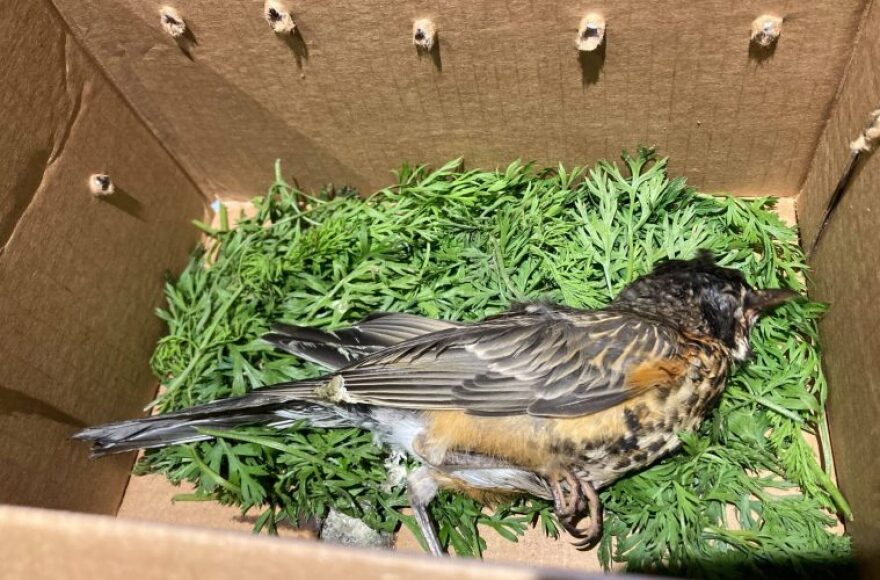Songbirds sick or dead from a mysterious illness have been reported in the eastern US, as far west as Indiana. Wildlife officials are asking people to take down bird feeders and remove birdbaths to potentially stop the spread of the mysterious illness.
One bird enthusiast who is abiding by the recommendation to take down feeders and baths is Cyndi Fink of Moon Township, just outside of Pittsburgh. Normally, her yard is full of songbirds coming for the sunflower seeds, nuts, birdbaths, and birdhouses. Even her cats have enjoyed birdwatching from the window, but not this summer.
“I work from home now, and I’m home all day, so it gives me something to look at when I am taking a break. There’s nothing to look at now,” she said. “My cats are kind of sad, too, that the birds aren’t getting fed.”
In late May, wildlife rehabilitation experts in Washington D.C. began receiving reports of sick or dead songbirds, mainly bluejays, starlings and grackles, but also robins, cardinals and others. The phenomenon has since spread through 10 states, including West Virginia, Ohio, Maryland and Delaware, and in 61 of 67 Pennsylvania counties, as of Tuesday.
Rachel Handle of the Audubon Society of Western Pennsylvania said people should be on the lookout for certain signs of the illness like crusty eyes.
“The birds showing symptoms of the illness have conjunctivitis or neurological problems, so they perhaps seem disoriented,” she said. Some birds have tremors or an inability to stand.
Handel said people should avoid handling dead birds, and keep pets away. The cause of the symptoms and deaths is not yet known.
“There are so many variables involved, getting to that root cause right now just has not happened,” she said.

Investigating the Cause
State wildlife agencies and the National Park Service are working with laboratories like USGS National Wildlife Health Center and the University of Pennsylvania’s School of Veterinary Medicine’s Wildlife Futures Program to investigate the cause.
The Wildlife Futures Program is helping track the numbers with an online form. As of Tuesday, 1,053 reports have been submitted, though they still have to be confirmed. According to Dr. Scott Weber, who runs the lab, most reports were from Pennsylvania. “It appears to be widespread throughout the commonwealth,” he said.
His lab has been conducting bird autopsies and a variety of testing to try to solve the mystery.
“That testing has included looking at four different toxins, looking for different bacterial diseases, for different viral diseases. We are also looking for parasites,” Weber said.
So why is it so hard to determine the cause? Weber said it’s just a matter of finding the pathogen.
“Especially if it’s a newly emerging disease where the pathogen hasn’t been identified before or cultured before,” he explained. “Any pathogens we do find [has to be] consistent with a lot of the cases that are being submitted.”
So far, researchers have ruled out some known pathogens like salmonella, avian influenza virus; West Nile virus, and Newcastle disease virus.
One theory is that it has something to do with the Brood X cicadas that emerged this spring. A theory that Weber says isn’t necessarily a dead end.
“We have looked at a toxin that was infecting the cicadas,” Weber said. “We’re looking at some of the pesticides used to control cicadas. It provides some information and it provides some direction in some cases.” Though he said so far the evidence hasn’t pointed to that as a cause.
Weber said that unknown disease spreads like this occur regularly. Just this past winter, songbird deaths were linked to a salmonella outbreak. While there is cause for alarm, Weber said he feels confident researchers will be able to find the cause.
In the meantime, people should not worry about birds having enough to eat when taking down their feeders.
“There’s ample food out there for them at this point in time, so they shouldn’t have many problems,” he said. “Hopefully this will at least subside prior to those colder winter months when there is more of a scarcity in food.”
EXPERTS ARE ENCOURAGING THE PUBLIC TO FOLLOW THESE FIVE PRECAUTIONARY MEASURES UNTIL MORE IS KNOWN:
- Cease feeding birds and providing water in birdbaths until this wildlife mortality event has concluded to prevent potential spread between birds and to other wildlife.
- Clean feeders and birdbaths with a 10% bleach solution.
- Avoid handling dead or injured wild birds. Wear disposable gloves if it’s necessary to handle a bird.
- Keep pets away from sick or dead birds as a standard precaution.
- To dispose of dead birds, place them in a sealable plastic bag and discard them with household trash. This will prevent disease transmission to other birds and wildlife.
Report sick or dead birds online
If you are looking for additional wildlife resources, please visit the Pennsylvania Association of Wildlife Rehabilitators.
Additional reporting by Boomba Nishikawa.
Read more from our partners, The Allegheny Front.




